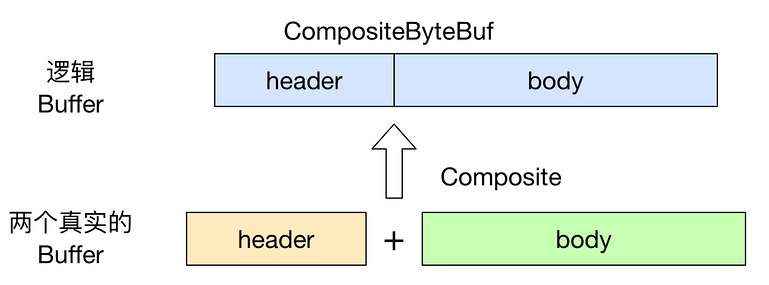# ByteBuf类:Netty的数据容器
ByteBuf维护了两个不同的索引:① readerIndex:用于读取;② writerIndex:用于写入;起始位置都从0开始:

名称以read或者write开头的方法会更新ByteBuf对应的索引,而名称以set或者get开头的操作不会。 AbstractByteBuf.readByte 代码如下:
public byte readByte() {
checkReadableBytes0(1);
int i = readerIndex;
byte b = _getByte(i);
readerIndex = i + 1;// 这里更新了索引
return b;
}
2
3
4
5
6
7
AbstractByteBuf.getByte代码如下:
public byte getByte(int index) {
checkIndex(index);
return _getByte(index);// 直接返回,没有更新索引
}
2
3
4
ByteBuf的使用模式
【1】堆缓冲区: 将数据存储在JVM的堆空间。好处:提供快速分配和释放;场景:遗留数据处理;
public static void heapBuffer() {
ByteBuf heapBuf = BYTE_BUF_FROM_SOMEWHERE; //get reference form somewhere
if (heapBuf.hasArray()) { //检查 ByteBuf 是否有一个支撑数组
byte[] array = heapBuf.array();//如果有,则获取对该数组的引用
int offset = heapBuf.arrayOffset() + heapBuf.readerIndex();//计算第一个字节的偏移量
int length = heapBuf.readableBytes();//获得可读字节数
handleArray(array, offset, length);//使用数组、偏移量和长度作为参数调用你的方法
}
}
2
3
4
5
6
7
8
9
如果hasArray()返回false,仍然去访问array()会抛出UnsupportedOperationException。
【2】直接缓冲区: NIO在JDK1.4中引入的ByteBuffer类允许JVM实现通过本地调用来分配内存。直接缓冲区的内容将驻留在常规的会被垃圾回收的堆之外。 如果数据包含在一个在堆上分配的缓冲区中,在通过套接字发送它之前,JVM会在内部把缓冲区复制到一个直接缓冲区中。
目的: 避免在每次调用本地I/O操作之前(后)将缓冲区的内容复制到一个中间缓冲区(或者从中间缓冲区把内容复制到缓冲区)
缺点: 直接缓冲区的分配和释放较堆缓冲区昂贵。
public static void directBuffer() {
ByteBuf directBuf = BYTE_BUF_FROM_SOMEWHERE; //get reference form somewhere
if (!directBuf.hasArray()) {//检查 ByteBuf 是否由数组支撑。如果不是,则这是一个直接缓冲区
int length = directBuf.readableBytes();//获取可读字节数
byte[] array = new byte[length];//分配一个新的数组来保存具有该长度的字节数据
directBuf.getBytes(directBuf.readerIndex(), array);//将字节复制到该数组
handleArray(array, 0, length);//使用数组、偏移量和长度作为参数调用你的方法
}
}
2
3
4
5
6
7
8
9
【3】复合缓冲区: 为多个ByteBuf提供一个聚合视图,可以根据需要添加或者删除ByteBuf实例。 CompositeByteBuf ByteBuf的子类,提供一个将多个缓冲区表示为单个合并缓冲区的虚拟表示。CompositeByteBuf中的 ByteBuf实例可能同时包含直接内存分配和非直接内存分配。

通过JDK的ByteBuffer实现:创建一个包含两个ByteBuffer的数组来保存消息组件
public static void byteBufferComposite(ByteBuffer header, ByteBuffer body) {
// Use an array to hold the message parts
ByteBuffer[] message = new ByteBuffer[]{ header, body };
// Create a new ByteBuffer and use copy to merge the header and body
ByteBuffer message2 =
ByteBuffer.allocate(header.remaining() + body.remaining());
message2.put(header);
message2.put(body);
message2.flip();
}
2
3
4
5
6
7
8
9
10
使用CompositeByteBuf实现的复合缓冲区模式:
public static void byteBufComposite() {
CompositeByteBuf messageBuf = Unpooled.compositeBuffer();
ByteBuf headerBuf = BYTE_BUF_FROM_SOMEWHERE; // can be backing or direct
ByteBuf bodyBuf = BYTE_BUF_FROM_SOMEWHERE; // can be backing or direct
messageBuf.addComponents(headerBuf, bodyBuf);//将 ByteBuf 实例追加到 CompositeByteBuf
//...
//删除位于索引位置为 0(第一个组件)的 ByteBuf
messageBuf.removeComponent(0); // remove the header
//循环遍历所有的 ByteBuf 实例
for (ByteBuf buf : messageBuf) {
System.out.println(buf.toString());
}
}
2
3
4
5
6
7
8
9
10
11
12
13
因为CompositeByteBuf可能不支持访问其支撑数组,访问CompositeByteBuf中的数据类似于直接缓冲区的模式:
public static void byteBufCompositeArray() {
CompositeByteBuf compBuf = Unpooled.compositeBuffer();
int length = compBuf.readableBytes();//获得可读字节数
byte[] array = new byte[length];//分配一个具有可读字节数长度的新数组
compBuf.getBytes(compBuf.readerIndex(), array);//将字节读到该数组中
handleArray(array, 0, array.length);//使用偏移量和长度作为参数使用该数组
}
2
3
4
5
6
7
# ByteBuf 字节级操作
ByteBuf提供了许多超出基本读/写操作的方法用于修改数据。
【1】随机访问索引:第一个字节的索引 0, 最后一个字节的索引:capacity()-1;
public static void byteBufRelativeAccess() {
ByteBuf buffer = BYTE_BUF_FROM_SOMEWHERE; //get reference form somewhere
for (int i = 0; i < buffer.capacity(); i++) {
byte b = buffer.getByte(i);
System.out.println((char) b);
}
}
2
3
4
5
6
7
【2】顺序访问索引:首先看下 ByteBuf的内部分段:
+-------------------+------------------+------------------+
| discardable bytes | readable bytes | writable bytes |
| | (CONTENT) | |
+-------------------+------------------+------------------+
| | | |
0 <= readerIndex <= writerIndex <= capacity
2
3
4
5
6
After discardReadBytes():对可写分段的内容并没有任何保证,因为只是移动了可以读取的字节以及writerIndex,并没有对所有可写入的字节进行擦除写。
+------------------+--------------------------------------+
| readable bytes | writable bytes (got more space) |
+------------------+--------------------------------------+
| | |
readerIndex (0) <= writerIndex (decreased) <= capacity
2
3
4
5
可以看出,ByteBuf被读索引和写索引划分成了3个区域:
● 可丢弃字节:已经被读过的字节,调用discardReadBytes()丢弃并回收空间(丢弃字节部分变为可写)。初始大小是0,存储在readerIndex中,随着read操作的执行而增加。
●可读字节:可读字节分段存储了实际数据。新分配的/包装的/复制的缓冲区的默认的readerIndex值为0。任何read或者skip开头的操作都将检索或者跳过位于当前 readerIndex的数据,并且将它增加已读字节数。如果被调用的方法需要一个 ByteBuf参数作为写入的目标,并且没有指定目标索引参数,那么该目标缓冲区的writerIndex也将被增加。如果尝试在缓冲区的可读字节数已经耗尽时从中读取数据,将抛出IndexOutOfBoundsException见下面代码
●可写字节:可写字节分段指一个未定义内容/写入就绪的内存区域。新分配的缓冲区的writerIndex的默认值是0。任何 write开头的操作都将从当前的writerIndex处开始写数据,并将它增加已经写入的字节数。
readBytes(ByteBuf dst)代码
public ByteBuf readBytes(ByteBuf dst) {
readBytes(dst, dst.writableBytes());
return this;
}
public ByteBuf readBytes(ByteBuf dst, int length) {
if (checkBounds) {
if (length > dst.writableBytes()) {
throw new IndexOutOfBoundsException(String.format(
"length(%d) exceeds dst.writableBytes(%d) where dst is: %s", length, dst.writableBytes(), dst));
}
}
readBytes(dst, dst.writerIndex(), length);
dst.writerIndex(dst.writerIndex() + length);
return this;
}
2
3
4
5
6
7
8
9
10
11
12
13
14
15
如何读取所有可读字节:
public static void readAllData() {
ByteBuf buffer = BYTE_BUF_FROM_SOMEWHERE; //get reference form somewhere
while (buffer.isReadable()) {
System.out.println(buffer.readByte());
}
}
2
3
4
5
6
如何往可写字节分段写数据:
public static void write() {
// Fills the writable bytes of a buffer with random integers.
ByteBuf buffer = BYTE_BUF_FROM_SOMEWHERE; //get reference form somewhere
while (buffer.writableBytes() >= 4) {
buffer.writeInt(random.nextInt());
}
}
2
3
4
5
6
7